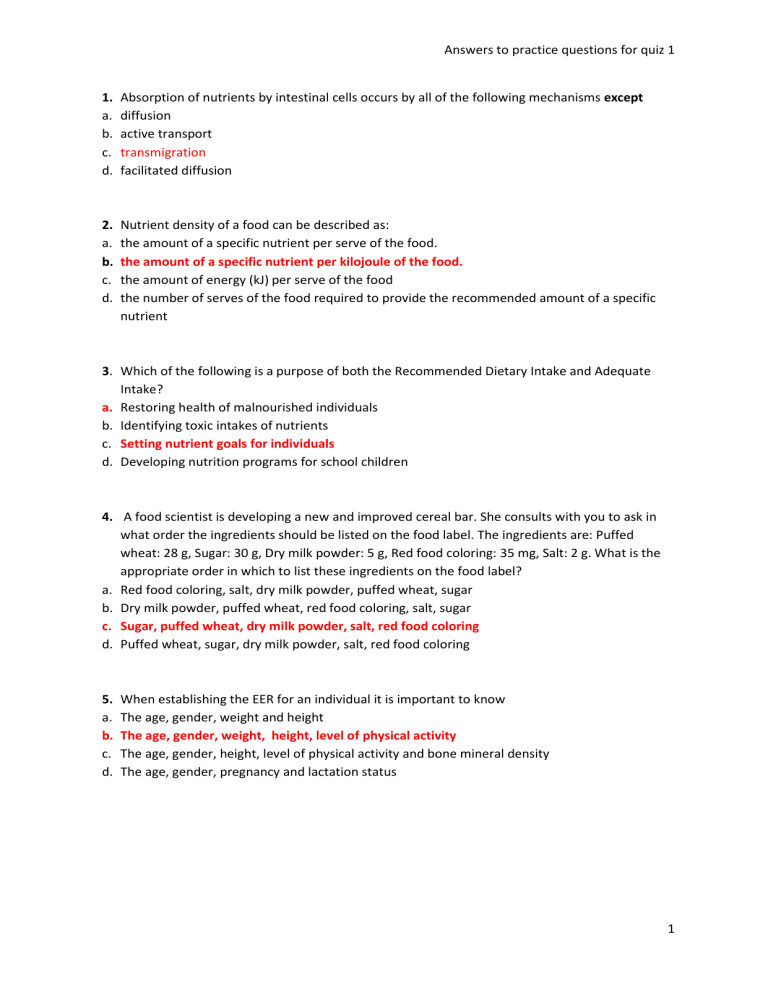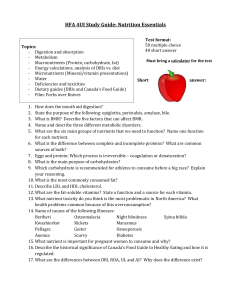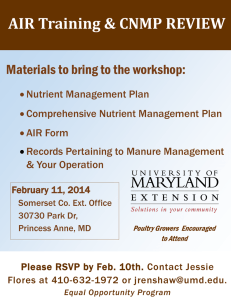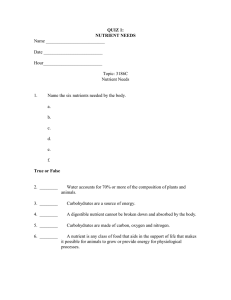
Answers to practice questions for quiz 1 1. a. b. c. d. Absorption of nutrients by intestinal cells occurs by all of the following mechanisms except diffusion active transport transmigration facilitated diffusion 2. a. b. c. d. Nutrient density of a food can be described as: the amount of a specific nutrient per serve of the food. the amount of a specific nutrient per kilojoule of the food. the amount of energy (kJ) per serve of the food the number of serves of the food required to provide the recommended amount of a specific nutrient 3. Which of the following is a purpose of both the Recommended Dietary Intake and Adequate Intake? a. Restoring health of malnourished individuals b. Identifying toxic intakes of nutrients c. Setting nutrient goals for individuals d. Developing nutrition programs for school children 4. A food scientist is developing a new and improved cereal bar. She consults with you to ask in what order the ingredients should be listed on the food label. The ingredients are: Puffed wheat: 28 g, Sugar: 30 g, Dry milk powder: 5 g, Red food coloring: 35 mg, Salt: 2 g. What is the appropriate order in which to list these ingredients on the food label? a. Red food coloring, salt, dry milk powder, puffed wheat, sugar b. Dry milk powder, puffed wheat, red food coloring, salt, sugar c. Sugar, puffed wheat, dry milk powder, salt, red food coloring d. Puffed wheat, sugar, dry milk powder, salt, red food coloring 5. a. b. c. d. When establishing the EER for an individual it is important to know The age, gender, weight and height The age, gender, weight, height, level of physical activity The age, gender, height, level of physical activity and bone mineral density The age, gender, pregnancy and lactation status 1 Answers to practice questions for quiz 1 6. According to the principles of The Australian Guide to Healthy Eating, the foundation of a healthful diet should consist of a. nutrient-dense foods b. energy-dense foods c. fruit d. meats and alternatives 7. a. b. c. d. Which of the following is not one of the six classes of nutrients? Lipids Minerals Water Alcohol Example short answer/calculation questions 8. Name two (2) of the 5 guidelines that underpin the Australian Guide to Healthy Eating (2 marks) 1. To achieve and maintain a healthy weight, be physically active and choose amounts of nutritious food and drinks to meet your energy needs 2. Enjoy a wide variety of nutritious foods from these five groups every day: 3. Limit intake of foods containing saturated fat, added salt, added sugars and alcohol 4. Encourage, support and promote breastfeeding 5. Care for your food; prepare and store it safely 9. A high-protein and very low-carbohydrate diet provides 137 g protein, 143 g fat, and 22 g carbohydrate per day. (3 marks total) a) How much energy will this diet provide? Show all calculations in your answer including how many kJ/g are associated with each macronutrient (2 marks) 137 * 17=2329 (1/2 mark) 143 * 37=5291 (1/2 mark) 22*17=374 (1/2 mark) Total energy= 7994kJ (1/2 mark) b) What percent energy comes from fat? (1 mark) Energy from fat/total energy x 100=5291/7994 * 100 = 66.2% 10. Which component of the gastro-intestinal tract in most important for absorption? (1 mark) Jejunum – small intestine 2 Answers to practice questions for quiz 1 11. Name two (2) factors that can influence the prevalence of gut bacteria • pH • Peristalsis • Diet • Microorganisms (2 marks) 12. What is the name given to the wavelike contractions that aid in moving a bolus of partially digested food components into the stomach? Peristalsis (1 mark) 13. Many breakfast cereals have a similar serving size suggested by the manufacturer but the nutrient density of carbohydrate can be quite different. a) What is the equation needed to calculate the nutrient density of carbohydrate? Amount of carbohydrate in the portion(g)/ energy in that portion (kJ) (1 mark) b) Which of the follow cereals has the highest nutrient density of carbohydrate – show your working in the table below (1.5 marks) Fruit loops Rank of Nutrient Density From highest (1)to lowest(3) 2 Nutrient Density calculation for carb =21.2/471 Food Serving size Energy (kJ) Total Fat (g) Carb (g) Protein (g) Sodium (mg) Special K 3/4 cup, 471 0.1 21.2 5.9 126 870 7.4 30 5.0 18 492 0.5 25.7 1.9 120 30 =0.045 g/kJ 3 =30/870 grams Muesli 1/2 cup, 55 =0.034 g/kJ 1 =25.7/492 grams Fruit loops 3/4 cup, 30 =0.052 g/kJ grams 14.What are the names of the two (2) enzymes that start the digestive process in the mouth and what macronutrients do they work on? (2 mark) Salivary amylase- carbohydrate 3 Answers to practice questions for quiz 1 Lingual lipase- fat 15. In planning a healthy diet there are 6 broad principles that should be adhered to. They are abbreviated to ABCDMV. Explain what the letter M refers to and how it is applied to meal planning? (3 marks) M- stands for moderation consider energy/nutrient ratio in planning foods consumed- this reflects total energy of the diet and also moderation of individual foods so portion size is considered in planning 16. There are several factors that influence food choices. Discuss two (2) of the factors discussed in lectures and give examples of how they may alter food choice (4 marks) The following options could be included- lecture 3 discussed how each of these may influence food choice and in the answer you should explain the impact • Personal Preference • Habit • Ethnic Heritage • Social Interaction • Positive and Negative Associations • Emotional Comfort • Values • Body Weight and Image • Nutrition and Health Benefits • Availability, Convenience and Economy 17.There are a number of factors that can alter basal metabolic rate- name three (3) factors and explain how they alter basal metabolic rate (3 marks) • Starvation- reduces BMR • Aging – reduces BMR • Sleep- reduces BMR • Fever- increases BMR • Growth- increases BMR • Stress- increases BMR • Lean tissue- increases BMR • Hormonal changes- some can increase and others can decrease BMR 4



